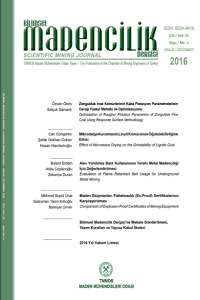Sülfürlü bakır-molibden konsantresinin asidofilik bakteriler ile seçimli biyoflotasyonu
Bu çalışmada, sülfürlü bakır-molibden cevherinden (%0,458 Cu, %0,042 Mo) elde edilen toplu Cu-Mo konsantresinin (%12,02 Cu, %1,37 Mo) biyoflotasyon
yöntemiyle zenginleştirme olanakları araştırılmıştır. Pülp pH’sı, bakteri türü ve bakteriyel kıvamlama süresi değişkenlerinin toplu Cu-Mo konsantresinden
kalkopirit ve molibdenit konsantrelerinin kazanımı üzerine olan etkileri incelenmiştir. Toplu konsantredeki kalkopiritin bastırılması amacıyla asidofilik
Acidithiobacillus ferrooxidans ve Acidithiobacillus thiooxidans türü bakteriler kullanılmıştır. Düşük pH’da (2-2,5) yapılan biyoflotasyon deneylerinde
seçimliliğin olmadığı görülmüştür. Acidithiobacillus ferrooxidans ile pH 5-6 aralığında yapılan biyoflotasyon sonucunda, %3,2 Mo içeren %88,2 verimle
bir molibdenit konsantresi ve %15,65 Cu içeren %80,6 verimle bir kalkopirit konsantresi üretilmiştir. Acidithiobacillus ferrooxidans türü bakterinin,
Acidithiobacillus thiooxidans’a göre kalkopiriti daha etkin bir biçimde bastırdığı belirlenmiştir
Selective bioflotation of copper-molybdenum sulfide concentrate with acidophilic bacteria
In this study, enrichment possibilities of bulk Cu-Mo concentrate (12.02% Cu, 1.37% Mo) obtained from copper-molybdenum sulfide ore (0.458% Cu,
0.042% Mo) by bioflotation method were investigated. The effects of pulp pH, bacteria type and bacterial conditioning time on the recovery of chalcopyrite
and molybdenite concentrates from the bulk Cu-Mo concentrate were investigated. For the depression of chalcopyrite from the bulk concentrate,
acidophilic Acidithiobacillus ferrooxidans and Acidithiobacillus thiooxidans bacteria were used. It was observed that there was no selectivity in bioflotation
experiments at low pH (2-2.5). As a result of bioflotation with Acidithiobacillus ferrooxidans at pH 5-6, a molybdenite concentrate containing 3.2% Mo
with 88.2% recovery and a chalcopyrite concentrate containing 15.65% Cu with 80.6% recovery were produced. It was determined that Acidithiobacillus
ferrooxidans bacteria depressed chalcopyrite more effectively than Acidithiobacillus thiooxidans.
